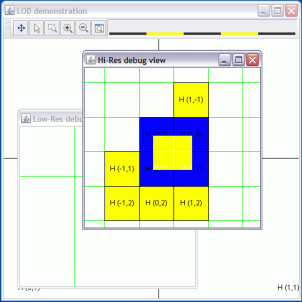Perforce JViews Maps Code Example: Load on Demand Basics
Description
 |
Perforce JViews Maps : (Legacy) How Load on Demand Works on non reprojecting data.
How to Run the Code Example as an Application
This code example can
be run as an application.
The installation directory contains
an executable JAR file,
lod.jar,
that allows you to execute the code example with a double click from a
file browser. Note that if you are using Internet Explorer, you can
open the installation directory
and execute the JAR file from the browser. This
technique may not work in other Web browsers.
Alternatively, you
can run the code example application from the command line.
First check that the Ant utility is properly configured. If not, see the
instructions on how to configure Ant for Perforce JViews.
Then, go to the installation directory
of the code example and type:
ant run
Topics Covered
- Using load on demand
Detailed Description
Perforce JViews Maps : This code sample illustrates how load on demand can be used when working with non reprojecting data, where the objects can be placed in a set of tiles that form a grid.
In a more general case, it is better to work with IlvFreeTile, where tiles can be overlapping after a projection is applied.
Installation Directory
The Load on Demand Basics code example is installed here.
Classes Involved
- ilog.views.tiling.IlvTile
- ilog.views.tiling.IlvTileLoader
- ilog.views.tiling.IlvTiledLayer
- ilog.views.tiling.IlvTileCache
- ilog.views.tiling.IlvTileController
- ilog.views.tiling.IlvTileLockFilter